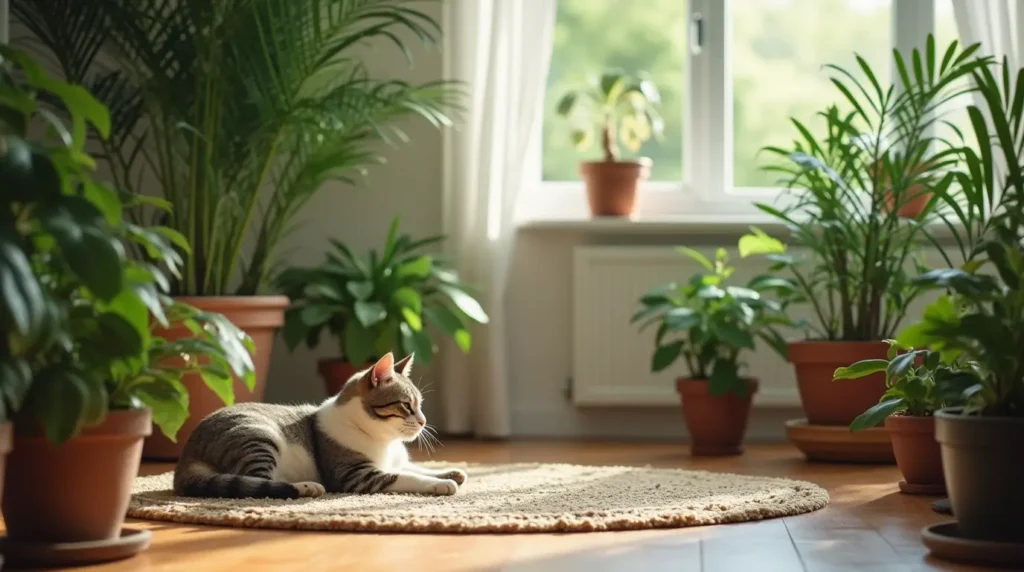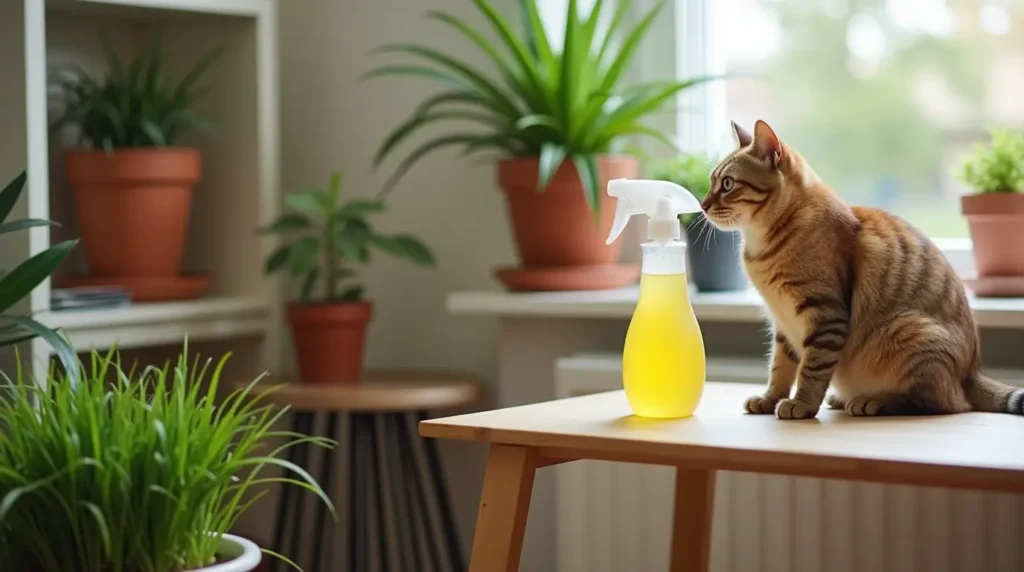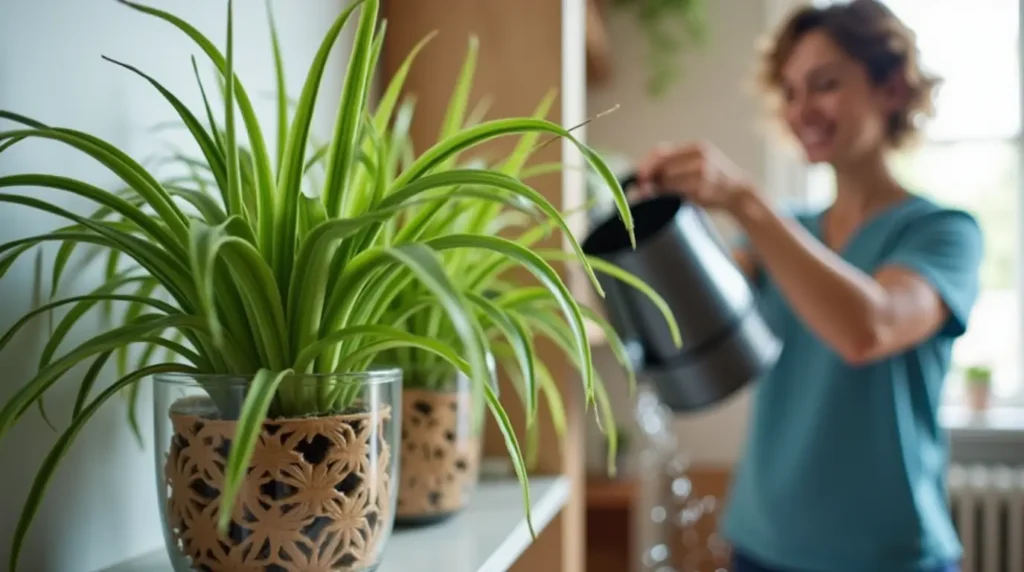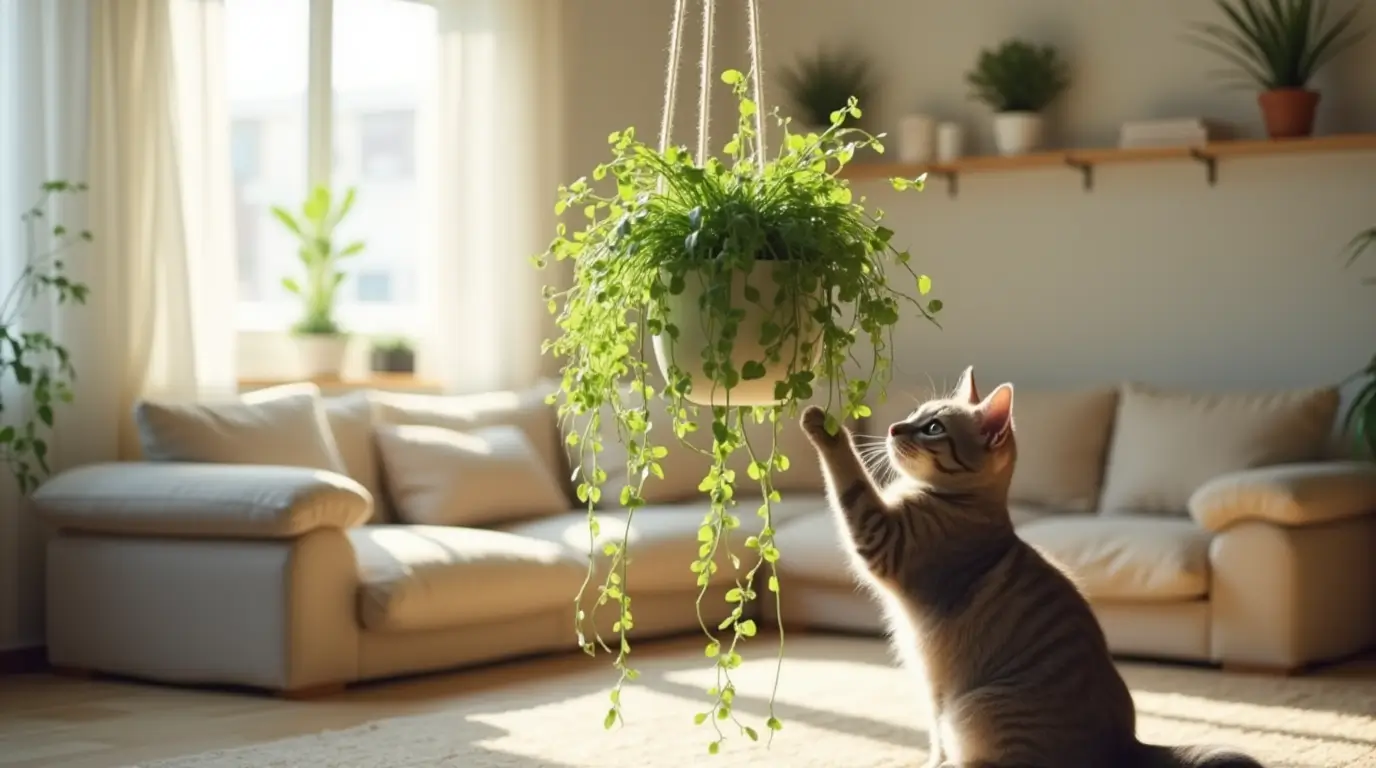Are Spider Plants Safe for Cats? Protect Your Pets Now.
If you’re a cat owner and a plant enthusiast, you might find yourself facing a common dilemma. You love your plants—after all, they brighten up your space, purify the air, and bring a touch of nature indoors.
But what about your curious, sometimes mischievous, feline companion? It’s no secret that cats love to nibble on anything within reach, especially when it involves those dangling leaves that look so inviting. So, how do you balance your love for greenery with the safety of your pet?
This brings us to the burning question: Are spider plants safe for cats? With so many houseplants potentially harmful to pets, it’s natural to wonder whether this popular, low-maintenance plant poses a risk.
After all, you don’t want your cat ingesting something that could harm them, but you also don’t want to give up your beloved plants.
In this article, we’ll dive deep into whether spider plants are safe for cats and how you can keep your home lush while protecting your feline friends.
So, if you’ve ever found yourself worrying about your cat munching on your spider plant, keep reading—let’s explore the truth about spider plants and cat safety!
Understanding Spider Plants and Their Popularity

Brief Overview of Spider Plants
Spider plants, scientifically known as Chlorophytum comosum, are among the most beloved houseplants around the world.
Their long, arching green leaves and distinctive white stripes make them an aesthetic choice for both seasoned plant enthusiasts and beginners alike.
But it’s not just their beauty that makes spider plants safe for cats—they are also known for being incredibly easy to care for, making them a popular choice for anyone looking to add some greenery to their home.
The versatility of spider plants is a key reason they are commonly found in homes. They thrive in a wide range of indoor conditions, from bright, sunny spots to areas with low light.
Whether you have a well-lit living room or a darker corner in need of a little greenery, spider plants are safe for cats and will likely adapt to almost any environment.
Plus, these plants grow effortlessly with minimal attention, requiring only occasional watering and well-draining soil to flourish.
Why People Love Spider Plants
There are several reasons why spider plants are safe for cats and so popular as houseplants. First and foremost, they provide excellent air purification.
These plants help remove harmful toxins from indoor air, improving the overall air quality in your home. If you’re someone who values clean, fresh air, the air-purifying properties of spider plants are safe for cats make them an excellent addition to your space.
Additionally, spider plants are safe for cats because they require minimal care. Busy homeowners or novice plant owners find spider plants especially appealing because they don’t demand much attention.
Unlike more high-maintenance houseplants, spider plants are safe for cats and only need occasional watering and indirect light to stay healthy. This makes them perfect for people with a lot going on or for those who may not have the greenest thumbs.
One of the best qualities of spider plants is their ability to grow in low-light conditions and tolerate varying temperatures.
Whether you’re in a sunny spot or a shaded nook, spider plants are safe for cats and will continue to thrive without requiring specific environmental conditions.
This adaptability makes them an attractive choice for urban dwellers, especially those who live in apartments or homes with less-than-ideal lighting.
From an aesthetic standpoint, spider plants are safe for cats and create a delightful visual focal point in any room. Their cascading leaves add a lush, tropical vibe to your home, making them a perfect choice for decorating without compromising on your pets’ safety.
To sum it up, spider plants are safe for cats, easy to care for, and purify the air, which is why they have become a staple in many households.
Their ability to thrive in various indoor environments, combined with their aesthetic appeal and practical benefits, makes them an obvious choice for pet owners looking for a stylish, pet-safe plant to incorporate into their home.
Are Spider Plants Safe for Cats? The Truth About Toxicity
Clarifying Toxicity Levels
When it comes to determining whether spider plants are safe for cats, the good news is that they are generally non-toxic.
This makes them a safer option than many other houseplants that may be harmful to pets. However, while spider plants are safe for cats, it’s essential to note that they are not entirely risk-free.
If your curious feline decides to nibble on a spider plant, it could experience some mild symptoms, which are usually not serious but can still cause concern.
According to the ASPCA and other veterinary guides, spider plants are safe for cats in terms of toxicity but may cause some digestive upset if ingested in larger amounts.
It’s important to remember that not all cats will experience symptoms, but if they do, these symptoms tend to be relatively mild and temporary.
Symptoms of Ingestion
If your cat happens to munch on a spider plant, you might notice one or more of the following symptoms:
- Vomiting: This is the most common reaction when cats ingest plants that aren’t part of their regular diet. If your cat eats too many spider plant leaves, they may vomit to expel the plant material.
- Diarrhea: Ingesting any plant matter, including spider plants, can lead to an upset stomach and cause your cat to have loose stools.
- Mild Stomach Upset: Cats may experience discomfort, such as drooling or a decrease in appetite, due to the mild gastrointestinal distress caused by eating the plant.
Even though these symptoms are typically not severe, it’s essential to monitor your cat and take action if they persist or seem to worsen.
Why Cats Might Be Drawn to Spider Plants
Cats are naturally curious creatures, and this curiosity often leads them to investigate and nibble on plants.
Spider plants are safe for cats, but their long, cascading leaves can be particularly enticing for your feline friend. The leaves move in the wind, which might attract your cat’s attention, prompting them to bat at or chew on them.
There are a few reasons why cats may chew on plants like spider plants:
- Boredom: If your cat doesn’t have enough toys or stimulation, it may turn to plants for entertainment. Chewing on something, especially plants, can offer a bit of relief from boredom.
- Curiosity: Cats are known for their inquisitive nature. If a plant is in their environment, it’s only natural for them to investigate and see if it’s edible or fun to play with.
- Hunger or Nutritional Deficiency: Sometimes, cats chew on plants as a way to supplement their diet. If they are not getting enough fiber or nutrients, they may instinctively turn to plants for help.
Even though spider plants are safe for cats in terms of toxicity, their appeal to curious cats can sometimes lead to them being chewed or ingested.
To minimize the risk, it’s essential to keep an eye on your cat’s behavior and take steps to prevent them from feasting on your plants.
How to Keep Your Cats Safe Around Spider Plants

Preventive Measures
While spider plants are safe for cats, it’s always a good idea to take steps to prevent your feline from chewing on them. Here are some effective preventive measures you can adopt to keep both your plants and your pets safe:
- Keep Plants Out of Reach: One of the simplest and most effective ways to protect your spider plant is by keeping it out of your cat’s reach. Consider placing your spider plants in hanging baskets or on high shelves that are inaccessible to your curious cat.
- Cat Deterrents: If your cat seems especially determined to chew on your plants, there are a few deterrents you can use. Cats tend to dislike the smell of citrus, so placing citrus peels near your plants can keep them at bay. There are also pet-safe sprays available that create an unpleasant taste or scent for cats but are harmless to your plants. These sprays can help dissuade your cat from nibbling on the leaves of your spider plants.
Providing Alternatives
If your cat enjoys chewing on plants, it’s essential to provide them with healthier alternatives. Cat grass is a great option because it’s specifically grown for cats and is safe for them to nibble on.
Additionally, there are other cat-safe plants that are designed to fulfill their need to chew while keeping them away from your spider plants.
Offering your cat an alternative like cat grass or catnip will give them a safe outlet for their chewing habits, reducing the chances of them being attracted to your spider plants.
Signs Your Cat Has Ingested Spider Plants
If you suspect your cat has eaten part of your spider plant, it’s important to know the signs of ingestion. Typically, symptoms will include:
- Vomiting: Your cat may throw up if it has ingested too much of the plant.
- Diarrhea: Loose stools can indicate that your cat’s digestive system is reacting to the plant matter.
- Lack of Appetite: Your cat might lose its appetite or become lethargic after eating the plant.
What to Do If Your Cat Ingests Spider Plants
If your cat eats a small amount of spider plant and shows mild symptoms such as vomiting or diarrhea, you may not need to panic. Typically, these symptoms will resolve on their own.
However, if your cat continues to show signs of discomfort, or if the symptoms become severe, it’s best to contact your veterinarian for advice.
In some cases, your vet may want to examine your cat or provide treatment to ensure there are no long-term issues.
Benefits of Having Cat-Safe Plants in Your Home
As a cat owner, it’s essential to maintain a pet-friendly home while still enjoying the beauty and benefits of indoor plants.
While spider plants are safe for cats, there are many other plants you can add to your collection that are both non-toxic and beneficial for your home environment.
The Role of Cat-Safe Plants
Maintaining a home that is both beautiful and safe for your pets is possible with the right plants. Having cat-safe plants in your home can improve your indoor air quality, brighten up your living space, and even provide some natural stress relief.
Non-toxic plants are the best way to strike a balance between aesthetics and safety for your pets.
Cat-safe plants help you keep a lush, green atmosphere while ensuring your feline companions can’t harm themselves. With a variety of non-toxic options available, you don’t have to sacrifice style for safety.
Best Cat-Friendly Houseplants
There are several houseplants that are safe for cats and can complement your home just as well as spider plants. Here are a few great choices to consider:
- Boston Fern: Known for its lush, feathery fronds, this plant thrives in humid environments and can tolerate low light.
- Areca Palm: This palm is not only safe for cats, but it also adds a touch of the tropics to your home with its feathery, arching fronds.
- Calathea: With its beautiful, patterned leaves, the Calathea is an eye-catching plant that’s also safe for your furry friends.
- Parlor Palm: Another pet-safe palm, the Parlor Palm, is perfect for adding a tropical feel to your home while remaining safe for your cats.
These plants, along with spider plants, offer a safe, non-toxic option for creating a vibrant, pet-friendly living space.
By including spider plants and other cat-safe plants in your home, you can enjoy the beauty of nature without compromising your pet’s safety.
Whether you’re a seasoned plant parent or new to indoor greenery, there are plenty of options to make your home both stylish and safe for your feline friends.
Alternative Solutions for Cat Owners

Cat-Friendly Plant Options
As a cat owner, you might be looking for more than just spider plants to brighten up your home. Fortunately, there are numerous other non-toxic plants that are perfectly safe for your furry friends.
If you’re worried about your cat nibbling on your plants, consider these alternative options that are both safe and beautiful:
- Boston Fern: Not only does it purify the air, but it also has soft, feathery leaves that cats love to look at but are completely safe to be around.
- Areca Palm: A great addition to your home, this palm is non-toxic and provides a tropical feel. It’s safe for cats and easy to care for.
- Calathea: Known for its vibrant, patterned leaves, Calatheas are another pet-friendly option that can thrive in lower light conditions.
- Parlor Palm: This small palm plant is perfect for apartment dwellers, offering both beauty and safety for your cat.
These plants, alongside spider plants, can help create a harmonious, cat-friendly environment without compromising your home’s aesthetic appeal.
Plant Care Tips for Pet Owners
When you’re caring for spider plants or any other indoor plants, there are a few things to keep in mind as a pet owner:
- Watering Schedules: Stick to a consistent watering schedule, but avoid overwatering your plants, as this can cause root rot. For spider plants, water them only when the soil is dry to the touch. Be sure to keep any excess water out of your cat’s reach, as stagnant water could attract your pets.
- Light Conditions: Most plants, including spider plants, thrive in indirect light. Ensure that your plants are placed in areas where they will receive the right amount of light without being exposed to harsh direct sunlight that could harm them.
- Safe Pesticides or Fertilizers: When it comes to pest control, always opt for pet-safe pesticides or natural alternatives. Many commercial pesticides are toxic to cats, so be sure to use organic or non-toxic solutions when treating your plants.
Taking these steps will help ensure that your plants thrive while also protecting your cats from any harm.
Frequently Asked Questions
Answering common questions about spider plants and cats can provide clarity for concerned pet owners. Here are some frequently asked questions that can help you make an informed decision:
- Are spider plants safe for cats if eaten? Yes, spider plants are safe for cats, but they may cause mild symptoms like vomiting or diarrhea if ingested in larger amounts. It’s best to keep an eye on your cat and prevent overconsumption.
- What should I do if my cat eats part of a spider plant? If your cat ingests part of a spider plant, monitor them closely for any signs of discomfort such as vomiting or diarrhea. Most cases are mild and resolve on their own, but if symptoms persist, contact your vet.
- Can spider plants cause harm to my dog as well? No, spider plants are safe for cats, and they are also considered non-toxic to dogs. However, it’s always wise to supervise pets and prevent them from chewing on any plants.
- Are there any signs I should look for if my cat eats a spider plant? Yes, watch for signs like vomiting, diarrhea, or lethargy. These symptoms are generally mild, but if they continue for more than a few hours, contact your vet.
- How do I keep my cat from chewing on plants? You can keep your cat from chewing on your spider plants by placing them in hard-to-reach spots, using cat-safe deterrents like citrus peels or sprays, or providing alternative plants like cat grass for them to enjoy.
Conclusion
In conclusion, spider plants are safe for cats, but like any plant, it’s important to monitor your cat’s behavior around them. While spider plants themselves are non-toxic, ingesting large amounts can cause mild stomach upset or digestive issues in cats.
By taking simple precautions—such as keeping your plants out of reach, using pet-safe deterrents, and offering safe alternatives for your cat—you can enjoy the benefits of spider plants and other plants in your home while ensuring your pets stay healthy and happy.
Remember, spider plants are safe for cats as long as you stay mindful of your pet’s curiosity and monitor them for any signs of discomfort.
With proper care and awareness, you can safely include spider plants and other cat-friendly plants in your home, creating a safe and vibrant environment for both you and your feline friends.

